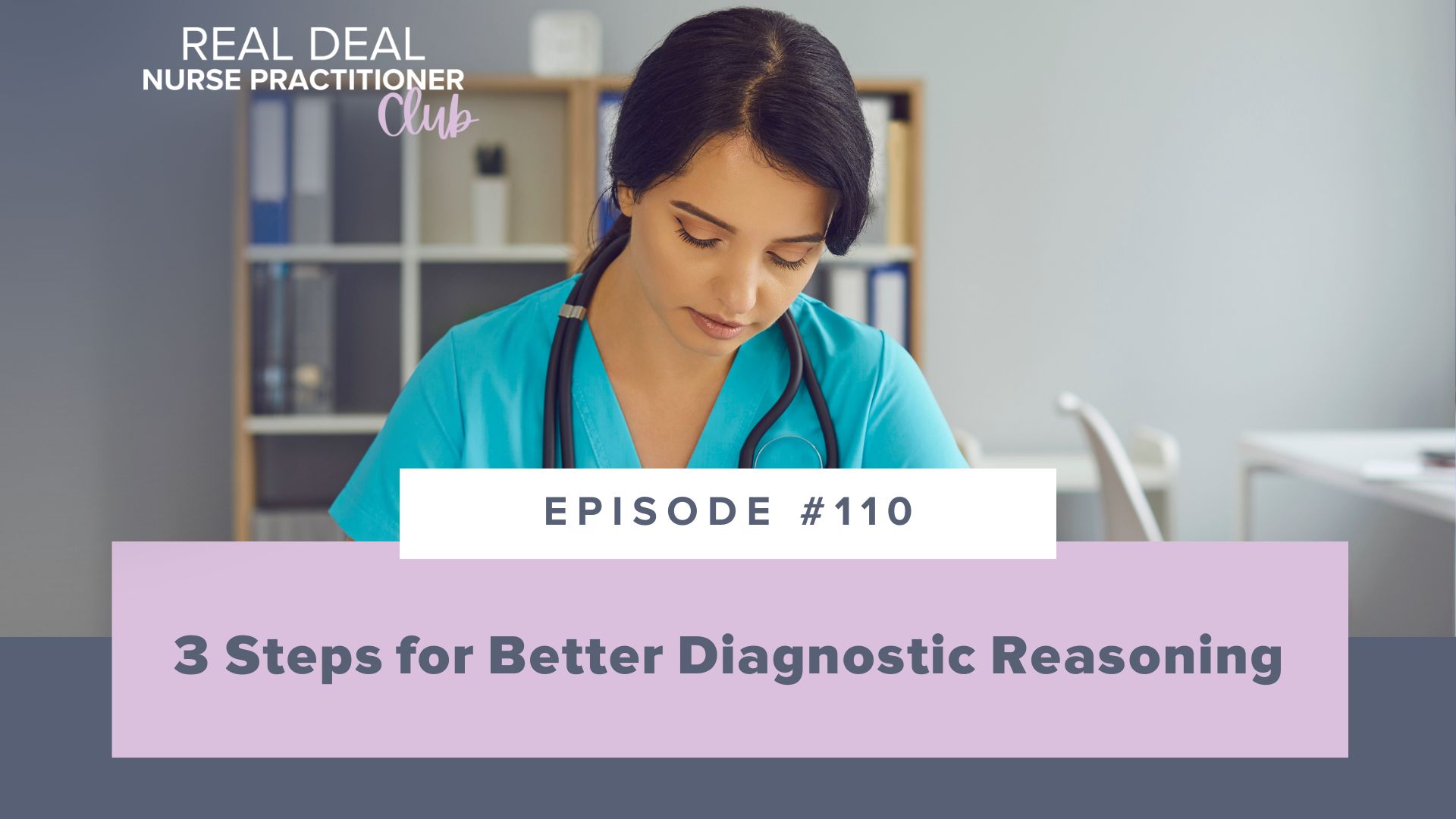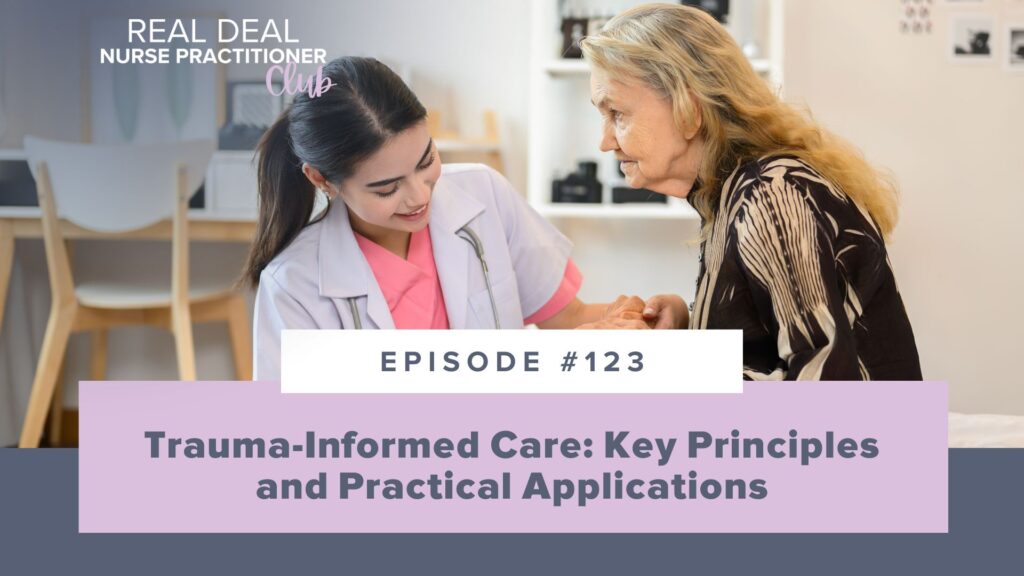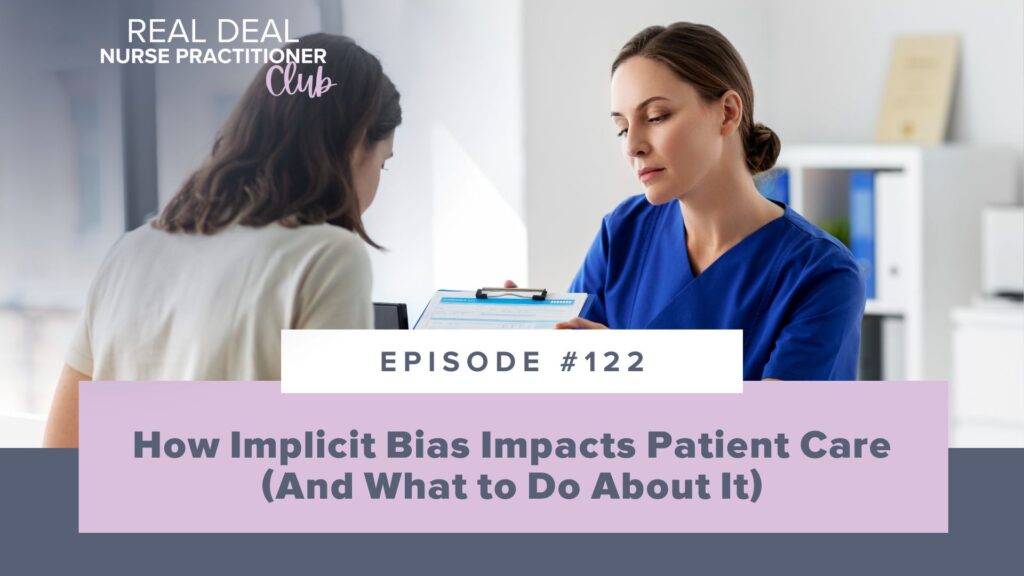Episode #110: 3 Steps for Better Diagnostic Reasoning
- by Sarah Michelle
- Apr 03, 2024
- Podcasts

Diagnostic reasoning is an essential skill for Real Deal Nurse Practitioners. A misdiagnosis can lead to unnecessary treatments, delayed treatment, and ultimately cause undue harm and stress to our patients. A major part of our role as NPs is diagnosing conditions, so we need to ensure our diagnoses are accurate.
Being a diagnostician is one of the most enjoyable parts of being a Nurse Practitioner. But with that enjoyment comes great responsibility. To help prepare you for life as a Real Deal Nurse Practitioner, we’re diving into diagnostic reasoning: the scientific process by which we diagnose our patients based on our knowledge and their symptoms.
Tune in this week for a vital overview of diagnostic reasoning. We’re providing you with key terms you need to understand regarding diagnosing your patients as a Nurse Practitioner, showing you how to avoid errors in diagnostic reasoning, and you’ll learn the three core steps of the diagnostic reasoning process.
What You Will Discover:
- What diagnostic reasoning is and why it matters.
- Why getting your diagnostic reasoning right always takes practice.
- The skills required for working towards flawless diagnostic reasoning.
- 3 core steps of the diagnostic reasoning process.
- How to hone your diagnostic reasoning skills as a Nurse Practitioner.
Featured on the Show
- Follow me on: Facebook | Instagram | YouTube | TikTok
- Follow us on TikTok and YouTube!
- Crash Course
- Live Study Group
Full Episode Transcript:

Welcome to the Real Deal Nurse Practitioner Club. Whether you’re hoping to become a real deal nurse practitioner or you already are one, this is the place for you to get the resources you need as you tackle this massive transition into practice. We’re your hosts, Sarah Michelle, Chief Nursing Officer of Blueprint Test Prep, and Anna Miller, Director of Nursing Content. And we’re here to hang out with you each week like your best friends in the NP space. Let’s dive in.
Sarah: Hello my friends. The topic today is about diagnostic reasoning, which is an absolutely essential skill for all of you real deal nurse practitioners out there. A major part of our role as NPs is diagnosing conditions, and with that we need to make sure that our diagnoses are accurate.
A misdiagnosis can lead to unnecessary treatments, delayed treatment and ultimately cause harm to our patients. And so we’re going to dive right in, and of course I have Anna joining me today to help explain some of these key ideas and some tips too for this.
Anna: Yes, one of my favorite parts of being a nurse practitioner is being what I like to call a diagnostician. But like you said, with that comes great responsibility. So to help prepare you as future or as new nurse practitioners, we are going to talk about what exactly is diagnostic reasoning, some key terms to understand and maybe take you way back to school, and also talk about how to avoid errors in diagnostic reasoning.
So, Sarah, can you kick us off here with what we mean by diagnostic reasoning?
Sarah: Yes. First up, diagnostic reasoning is the scientific process by which we as the provider suspect a diagnosis based on a patient’s presenting signs and symptoms, combined with their previous knowledge, ability to gather relevant information and select and interpret necessary tests.
And so, Anna, what does working through the diagnostic reasoning process really allow us to do?
Anna: Yeah, so through this process, and with lots and lots of practice, I definitely want to stress that, we can learn to improve our history taking skills so we know what needs to be asked, and then also what needs to be examined.
Diagnostic reasoning also helps us to order diagnostic tests accurately because if we have our list of likely differential diagnoses to work with, then we can use that information to order tests to either confirm or rule out certain conditions.
Sarah: Exactly, and the diagnostic reasoning process involves like three core steps. Data collection, data processing, and problem list development. And we do most of this stuff without necessarily realizing that that’s exactly what we’re doing.
So the first step I mentioned, that data collection, includes all of the information that we obtained during the HPI and our physical exam. So did you ask the right questions? Did you assess the right body systems? Were you thorough enough? It also includes any lab work or diagnostic tests that we ordered. And if you order a test, you need to be sure that you know how to interpret those results.
Anna: Yeah, interpreting results definitely took me some practice, right? When I entered, I found that I knew what to order at the beginning, but then it was what to do next, right? And our next step is data processing, or just how we deal with all the information we just gathered.
A lot of times you don’t even realize how your brain processes information, but our brains love to look for patterns. So we look for patterns that fit certain diseases. We also want to consider red flags or do not miss diagnoses. And then, Sarah, what’s the last step or what comes next?
Sarah: The third step in diagnostic reasoning that I mentioned is problem list development. You’ll often hear this referred to, especially in school, as that differential diagnosis list. And after you’ve gathered all of the information and processed it, you might be left with some possibilities as to what is affecting this particular patient.
So even if at the end of the patient visit you know what the diagnosis is, you still had to work through several differential diagnoses before you got there.
Anna: Yeah, I think an easy example of this is just think of a patient reporting a sore throat. Is it strep throat, mono, GERD, postnasal drip, or irritation from exposure to something, something malignant? That relatively simple concern can have so many possibilities.
Sarah: And we might not always exactly know what the diagnosis is by the end of that patient visit, and that’s okay. But we have some ideas in mind. And that’s when we start ordering labs or other tests to help confirm our very educated suspicions and to help rule out other diagnoses on our list.
Diagnostic reasoning isn’t always just like a smooth or linear process, but with practice and experience, it does get better and easier.
To help really just better understand the process, I think we should go over some important terms too. So have you ever heard about Occam’s razor or different ways of hypothesis testing? And then what about things like sensitivity and specificity? If you’re going, “What in the world are you talking about right now?” Don’t worry, because we’re going to talk about each and every one of these.
Anna: Yeah, definitely get ready for some good trivia here, my friends. I know you mentioned Occam’s razor. So Occam refers to William of Ockham, who was a Franciscan monk in the early 14th century. But essentially he is quoted as creating a principle that plurality ought never be posed without necessity.
Basically, what that means is that the simplest unifying answer to a question is the one most likely to be correct. And then other less satisfactory ideas or explanations are kind of just shaven off in the process.
Now, this theory does not necessarily just pertain to medicine, but other aspects of science as well. So can you give an example of this in action to show why it’s pertinent, Sarah?
Sarah: Yes, we definitely need an example to make this make sense. So let’s say you have like, I don’t know, a 44 year old patient with an increased BMI. And they’re presenting to your office for something like right shoulder blade pain. And they’re going to tell you that the pain seems to occur after a big meal. Sometimes it’s accompanied by heartburn, maybe some mild abdominal pain, cramping.
And so does it make more sense to diagnose her with a muscle strain, GERD, an irritable bowel syndrome? Or can we neatly explain all of her symptoms with a diagnosis of cholelithiasis? Exactly. It makes more sense that it is likely a gallbladder issue than multiple other issues at once.
And so, Anna, let’s kind of move on to our next term now and talk about that hypothesis testing.
Anna: Yeah, hypothesis brings me back to high school science class and learning the scientific method. But it is really something we create all the time as nurse practitioners. Just remember, hypotheses are not diagnoses. They’re our ways of connecting some of the information that has been given.
So for example, epigastric pain of three months duration is probably not something like acute gastroenteritis, but more likely a chronic issue like a gastric ulcer. So our hypotheses are kind of like the beginning of that differential diagnosis list.
Sarah: Yes. And then once we’ve generated those, hypotheses can be tested for certain characteristics. So does the pathophysiology, predisposing factors and complications for this disease present in the patient? Does the suspected disease encompass all the patient’s normal and abnormal findings? And is this the simplest explanation of the patient’s findings?
Lastly, can a competing hypothesis be eliminated? What other conditions could explain this patient’s symptoms?
Anna: Yeah, and like we said before, we often do a lot of these processes subconsciously, but it’s just important to understand how our brain works and understand those different ways we can help it along.
Sarah: Yes, so true. And we’re not here to make this feel like a science or a vocabulary lesson, but diagnostic reasoning really is a scientific process with a lot of different components. And the last terms that we want to go over are sensitivity and specificity.
I’m going to be very honest and transparent, it took me a long time to wrap my head around these two. And you most commonly hear them in reference to the accuracy of just different diagnostic tests.
Starting off with sensitivity, this is based solely on patients with the disease. It is equal to the true positive rate, or basically just how well does a test pick up on patients with the disease that it’s looking for? For example, if a test has a sensitivity rating of 85%, it means that 85% of the time the tests that were positive were true positive results. This also means that 15% of the time there were some false positives. And so we want a sensitivity rating, in the ideal world, as close to 100% as possible.
Anna: Yeah, absolutely. And that specificity is kind of, I kind of think of it like the opposite. It is based on individuals without the disease. So it is equal to the true negative rate, or how well the test differentiates individuals without the disease.
So an example of this would be to say that a test has a specificity of 70%. That would mean that 70% of the time, a negative result was a true negative. But that also means there is a 30% false negative rate. So same as sensitivity, we want a specificity rating as close to 100% as possible.
Sarah: And that’s really just because we want to limit false positives and false negative results. Those put our patient at risk for possible unnecessary further testing and treatments. And so to recap, sensitivity, true positive rate. Specificity, true negative rate. And both are equally important.
Now that we’ve talked about the diagnostic reasoning process and some important terms to help guide us in our decision making, now we need to talk about how we can make sure, or at least limit the potential for diagnostic errors.
Diagnostic errors fall typically into three categories. No fault errors, systems errors, and cognitive errors. To start, no fault errors are really just beyond our control. Someone may have a silently presenting condition or it presents in such an atypical way that even a reasonable, seasoned, experienced provider would miss it. Or the medical technology just hasn’t caught up enough to be able to pick up on it. And this can be said for some of those rare genetic conditions.
Now, what about system errors, Anna?
Anna: Well, system errors reflect healthcare system flaws, right? Is the medical record outdated or cumbersome and impeding your ability to coordinate care? Did you not have enough training in your role? Are you just overworked, fatigued, and stressed out? All of which I’ve heard before, and all of which could lead to poor diagnostic reasoning. And you can limit system errors by advocating for better policies.
And then I think you mentioned cognitive errors, Sarah. So what are those?
Sarah: Cognitive errors are the ones that we have the most control over to be able to overcome. So these are errors in our way of thinking. Examples of cognitive errors include jumping to conclusions, flawed perceptions, faulty logic, using those biased rules of thumb, and making that final diagnosis too early. So remember, earlier Anna was talking about our brains like to look for patterns, this really falls into that cognitive error spot.
Anna: Yeah, and going off of that, I do want to talk a little bit more about the concept of heuristics or those rules of thumb, like you said. They can be really helpful to guide thinking and make things more efficient. So for example, a patient with a high fever and sharp pain in the right lower quadrant, we think appendicitis, right? That’s kind of our rule of thumb.
But heuristics can be faulty if the presentation is atypical or the condition is not common. And that can cause some tunnel vision and a focus on one diagnosis too much. Remember, rarely in practice do things present just like that textbook answer, so we need to remain open to the low probability of a serious diagnosis and just always be thinking about those red flags and ruling them out.
Sarah: Yeah, I think that’s a really good summary of how to avoid those cognitive errors. So just don’t get that tunnel vision. I know it’s hard. And we can also run into confirmation bias, which is that tendency to place too much weight on evidence that favors our preliminary diagnoses and then we ignore or we just don’t look further into evidence to the contrary.
An example of this would be to say we have a patient with a history of anxiety and they continue to report worsening symptoms like constant worry, palpitations, now they have some weight loss. Confirmation bias would be to continue down the path of anxiety treatment without being open to other causes. Perhaps this patient has hyperthyroidism as an underlying cause. So we always just really need to keep that open mind and avoid getting fixated on certain ways of thinking.
Anna: Yeah. Oh, okay, this was a big episode and we covered a lot of great stuff.
Sarah: Yes.
Anna: And I know some of these terms and diagnostic reasoning as a scientific process, all of this can sound and feel a little intimidating and overwhelming, but remember your brain does so much of this work behind the scenes. Like you are already doing it every single day in practice or your clinical rotations and just have faith in your nurse practitioner training. And remember, you’ve got us here to just help guide you along the way as well.
Sarah: Absolutely, we are always here for you, whether you are a future real deal NP or you are the real deal NP. And you can of course listen to this podcast anytime that you need that refresher again. And as always, thank you to each of you for tuning in and we’ll be talking to you soon.
As an extra bonus friends, if you’re looking for support no matter what phase of your nurse practitioner journey that you’re currently in, I have communities available for both students and new nurse practitioners. In these communities, we work to uplift one another and grow this profession together every single day. Links to join will be included for you in the show notes.
Thanks for listening to Real Deal Nurse Practitioner Club. If you want more information about the different types of support that we offer to students and new nurse practitioners, you can visit npreviews, with an S, dot com. We’ll see you next week.
Enjoy the Show?
- Don’t miss an episode: follow the podcast on Spotify, Apple Podcasts, Google Podcasts, or RSS.
Related Posts
Search the Blog
Join our Facebook Group!
Get FREE support and encouragement from thousands of FNP/AGPCNP students and our NP Support team.
Learn More3 Study Hacks to Conquer Your NP Exam!
Download these tips that have helped thousands of students pass their NP board exams.
Download NowInstitutional Partnerships
Are you a faculty member and would like to bring Sarah Michelle’s resources to your school? Email us at nursinggroups@blueprintprep.com for special institutional pricing or click on the link below to learn more.
Learn MoreGroup Discounts
Are you a student and have 10 or more classmates interested in purchasing Sarah Michelle’s courses? Email us at nursinggroups@blueprintprep.com for special pricing.



